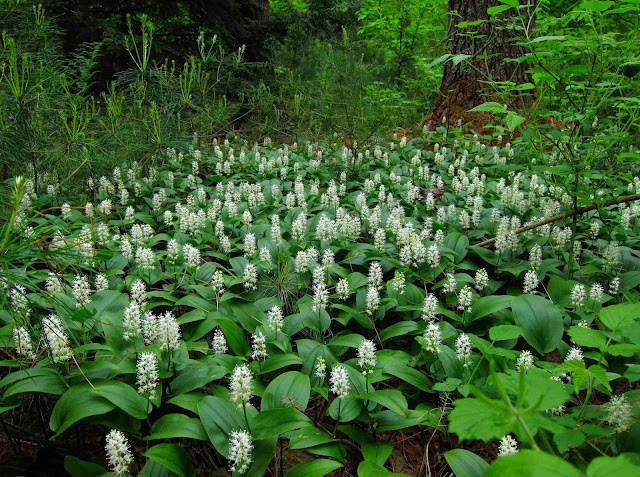What fun to have my friend Sue on holiday today, so we could explore together a wonderful piney woods a few miles north of Warrensburg. We had visited this woods together a couple of years ago, and we remembered nearly swooning from the sweet heady fragrance of thousands and thousands of Canada Mayflowers in bloom beneath the tall pines. And yes, we found them here again this year -- and in full glorious bloom and bounteous aroma! How to describe their fragrance? Sweet and fruity, a little bit like grape lollipops. But better. Heavenly! And they're also really pretty.
Just as pretty, if not quite so abundant, were the dozens and dozens of Pink Lady's Slippers in beautiful bloom on Monday, sharing that same woods as the Canada Mayflower and lots and lots of wee tiny pines.
I don't believe I have ever before seen a Pink Lady's Slipper so deeply pink. What a rich wonderful color -- the visual equivalent of the rich wonderful fragrance we breathed as we gazed at the Lady's Slippers' beauty.
In the same vicinity under the pines, the Yellow Clintonia was also coming into its glory.
After sating our senses with the beauty and fragrance of all that grew in the woods, we next moved out to the shore of the Hudson River, which here at this spot possesses banks of the most amazing marble.
So many different shapes and colors and swirls of what once was molten rock! It almost looks as if it were flowing still.
Tucked in among these swirling and crystalline rocks were a number of beautiful flowering plants, including the rare Dwarf Sand Cherry, its sprawling branches loaded with white, fragrant blooms.
Another pretty plant that thrives here is Star-flowered Solomon's Seal, each stem of blue-green leaves topped with a cluster of star-shaped white flowers.
We weren't the only ones enjoying these pretty flowers today, although I believe this female Scorpion Fly was more interested in the food it provided her than she was in its beauty. Sue was the one who first spotted this interesting insect, and when I asked her how it came to be called a Scorpion Fly, she told me that if I were to see the male of this species, I would know why. If you Google "Male Scorpion Fly," you can see photos of its enlarged sexual organ, which does indeed look like the business end of a scorpion.
The flowers that grew among these rocks presented quite a colorful display, with these Golden Alexanders glowing a vivid yellow.
Clusters of dainty Bluets added their radiant blue hues.
Hedges of some species of Low Blueberry shrubs provided a charming multi-color display, the pink-blushed yellow blooms held in bracts of the loveliest turquoise-blue.
Bastard Toadflax held buds and blooms of purest white.
Wild Columbine brought the most smashing colors of all, their glowing scarlet outer parts enclosing intricate structures of bright-yellow.
After exploring the marble outcroppings that line the shore here, we next ventured downstream to a flatter area along the river, a stretch of sandy, gravely beach.
The flowers of New Jersey Tea or of Frostweed or of Tubercled Orchids were as yet nowhere to be found, nor were the tall stalks of flowing white Canadian Burnet that we knew to grow here. But the baby leaves of Canadian Burnet, deeply scalloped and rimmed in red, were every bit as pretty as their flowers will ever be when they bloom late in summer.
We also found some interesting sedges, including the rare Buxbaum's Sedge, with its rather attractive seed heads colored a translucent lime green striped with black.
I don't know the name (as yet) of this attractive sedge, with its long male inflorescences colored a deep mustard yellow. Many clumps of it were growing right next to the water in damp sand, so we can surmise it prefers a wet habitat.
These Lance-leaved Violets were our last surprise of our visit, since we did not remember finding them here before. I wonder how we could have missed them, since they were growing in abundant numbers, and again, very close to the river's edge, in damp sand.





















No comments:
Post a Comment